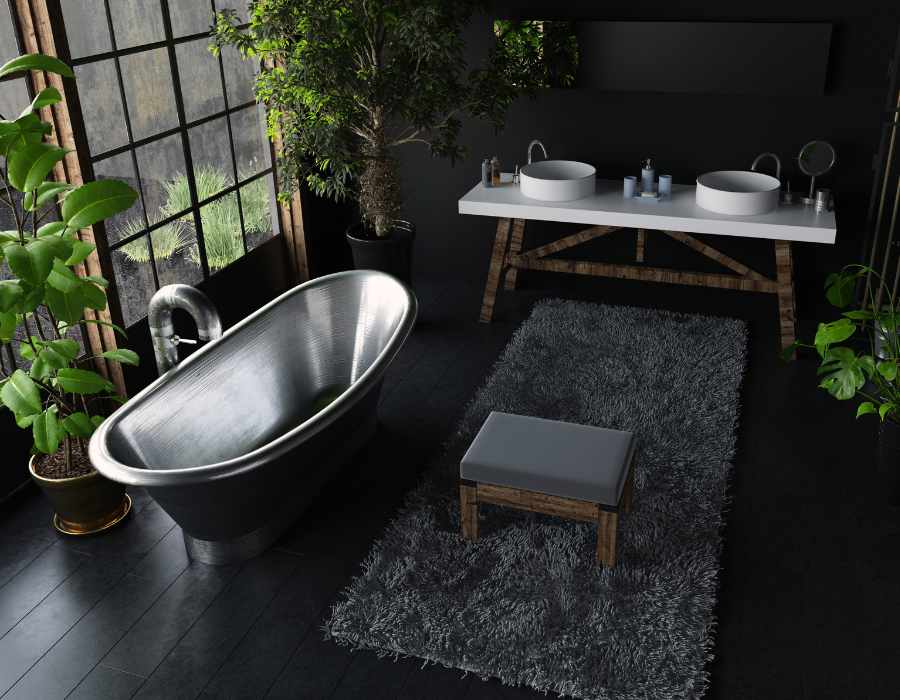What are Tubs Made of? A Breakdown of Bathtub Materials

When it comes to remodeling your bathroom, one of the key decisions you’ll make is choosing the perfect tub. With so many walk-in bathtub materials on the market, it can be tricky to decipher which is right for your space, style, and budget.
In this comprehensive guide, we’ll dive into the most common bathtub materials, helping you understand what tubs are made of and how to choose the right material for your bathtub replacement.
Types of Bathtub Material

Acrylic Tub
Acrylic bathtubs are crafted from vacuum-formed acrylic sheets, reinforced with fiberglass to add strength and durability.
Acrylic tubs are known for their lightweight nature, ease of installation, and excellent heat retention, making them a popular choice for both standard and whirlpool bathtubs. The non-porous surface of an acrylic bathtub makes them resistant to staining and easy to clean, though they can be susceptible to scratches.
Fiberglass (FRP) Tub

Fiberglass tubs, also known as FRP (Fiberglass Reinforced Plastic), are made by shaping a layer of fiberglass into a bathtub mold and coating it with a gel coating.
Fiberglass tubs are the most budget-friendly option, extremely lightweight, and easy to install, making them a common choice for quick bathroom updates. However, the surface of a fiberglass tub can be porous and prone to fading and cracking over time.
Porcelain on Steel (Enamel Steel) Tubs
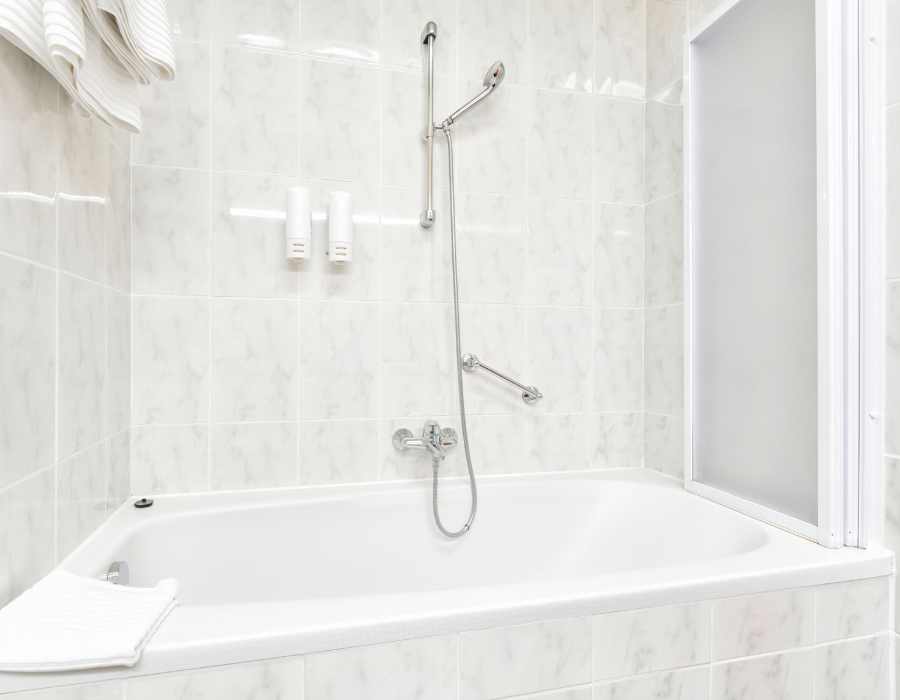
Enameled steel bathtubs are made by coating a thin steel sheeting with porcelain enamel, resulting in a durable, non-porous surface that’s easy to clean. These tubs combine the strength of steel with the glass-like shine of porcelain, offering a classic look.
While enameled steel tubs are resistant to most chemicals and abrasive cleaners, the enamel coating can chip if struck hard enough, exposing the steel beneath to potential rust.
Cast Iron Tubs
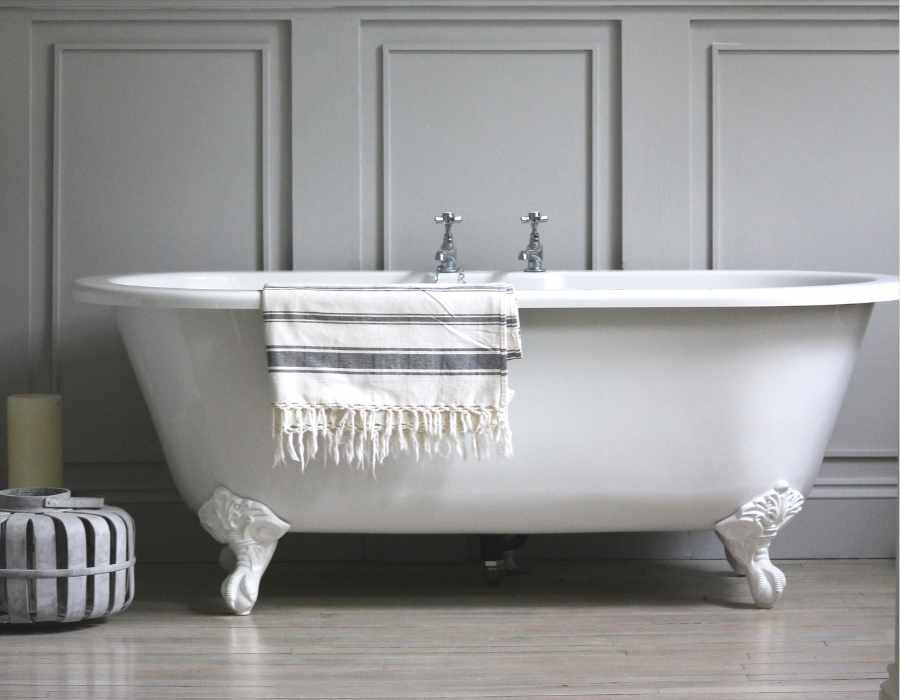
Cast iron tubs are molded iron coated with a thick layer of porcelain enamel, making them highly durable and resistant to scratches and chemicals. Known for their luxurious feel and exceptional heat retention, cast iron bathtubs are a premium choice, often found in traditional and freestanding designs.
However, the extreme weight of a cast iron bathtub requires careful consideration of structural reinforcement in your bathroom.
Solid Surface Bathtub

Solid surface bathtubs are made from a blend of materials such as crushed stone and acrylic resin, offering a luxurious bathtub material similar to natural stone without the high cost or maintenance.
Solid surface tubs are known for their durability, non-porous nature, and ability to retain heat, making them a popular choice for upscale bathroom designs.
Stone Resin Tubs

Stone resin tubs are a composite material made from a mix of natural stone dust and polymer resin, providing the appearance and feel of natural stone with improved heat retention and durability.
Stone resin bathtubs are solid, non-porous, and easy to maintain, offering a modern and luxurious aesthetic to any bathroom.
Copper Tubs
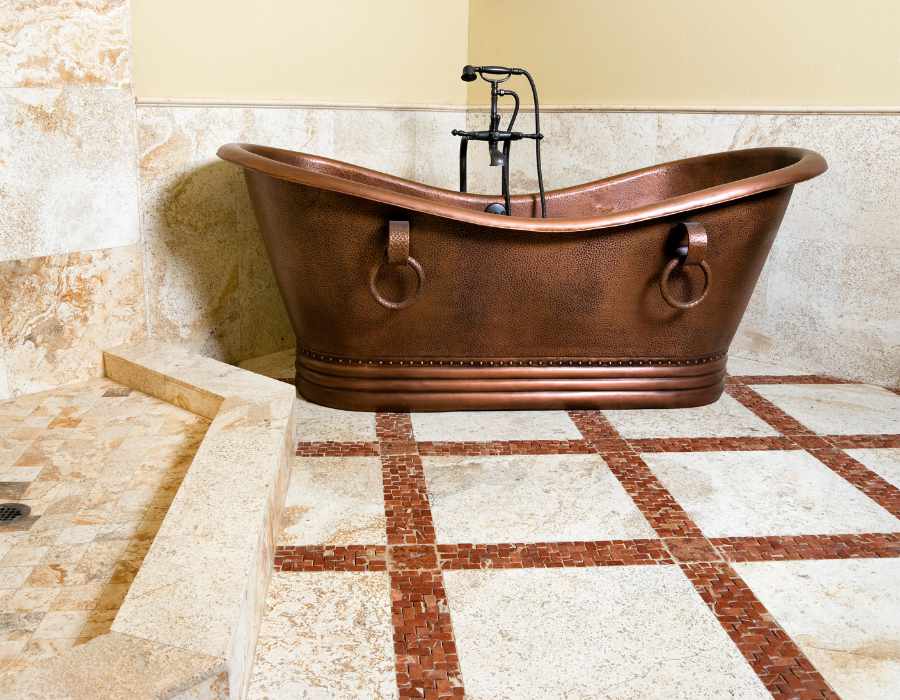
Copper bathtubs offer a unique, opulent look that can transform any bathroom into a luxurious retreat. Known for their natural antibacterial properties and excellent heat retention, copper tubs age gracefully, developing a rich patina over time.
While copper tubs are highly durable and retain water heat well, their premium material and craftsmanship come at a higher cost.
Wood Tub
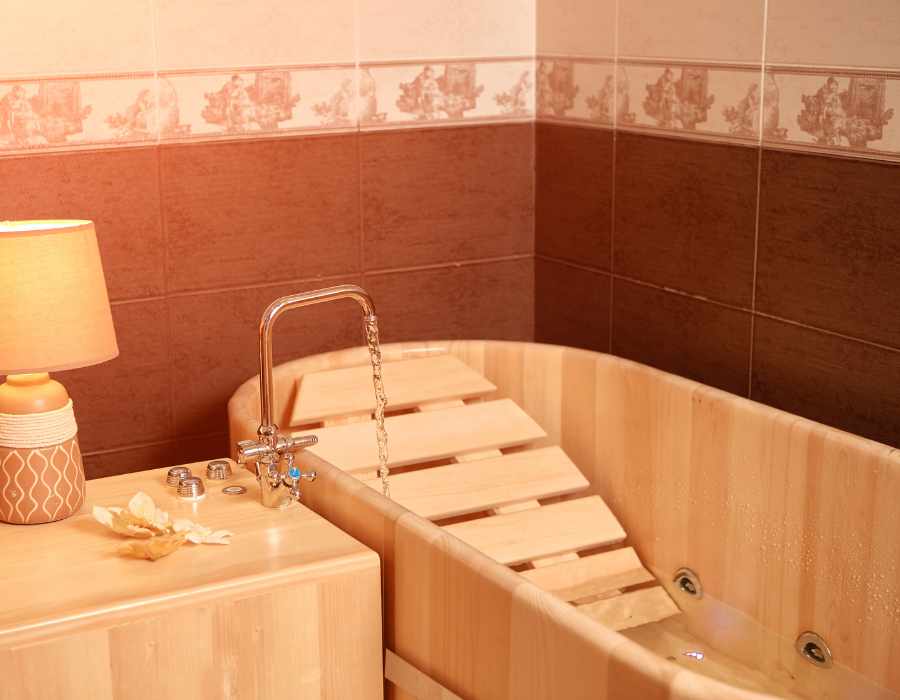
Wood bathtubs, often crafted from water-resistant woods like teak or cedar, bring a natural and organic element to the bathroom. They require regular maintenance to maintain their waterproof seal and can be custom-made to fit any bathtub shape or size.
Wood tubs are a unique and luxurious option for those looking to make a statement in their bathroom design.
Pros and Cons Summary of Each Material
When choosing a bathtub, understanding the strengths and weaknesses of each material can significantly impact your decision. Here’s a concise breakdown to help you navigate your options:
Acrylic
- Pros: Lightweight, excellent heat retention, a wide variety of shapes and designs, resistant to cracking and chipping, easy to repair.
- Cons: Can scratch easily, may not feel as sturdy as heavier materials.
Fiberglass (FRP)
- Pros: Very affordable, lightweight, easy to install, a good option for temporary solutions or rental properties.
- Cons: Less durable, prone to fading, scratching, and cracking over time, shorter lifespan.
Porcelain on Steel (Enamel Steel)
- Pros: Durable, easy to clean, resistant to most chemicals, retains glossy finish, affordable.
- Cons: Can chip, leading to rust, heavier than acrylic or fiberglass, limited in shape and size options.
Cast Iron Tub
- Pros: Extremely durable, classic look, excellent heat retention, resistant to scratches and chemicals.
- Cons: Very heavy, requiring additional floor support, more expensive, difficult to move and install.
Solid Surface
- Pros: Mimics the look of natural stone, durable, non-porous, easy to maintain, retains heat well.
- Cons: Can be expensive, heavy, and may require professional installation.
Stone Resin
- Pros: Offers the aesthetic of natural stone, durable, good heat retention, non-porous, and easy to clean.
- Cons: Heavy, can be on the higher end of the price spectrum, may require reinforced flooring.
Copper
- Pros: Unique appearance, natural antibacterial properties, excellent heat retention, durability, ages gracefully.
- Cons: Expensive, requires some maintenance to preserve the finish, patina development may not be desirable for all.
Wood
- Pros: Natural and unique aesthetic, can be custom-made, adds warmth to bathroom decor.
- Cons: Requires regular maintenance to prevent water damage, susceptible to rot if not properly cared for, expensive.
How to Choose the Right Material for Your Bathtub Replacement
When selecting a new bathtub with walk-in shower, consider factors like durability, maintenance, heat retention, and aesthetic appeal. Acrylic and fiberglass bathtubs are great for those on a budget or needing an easy-to-install option, while cast iron and solid surface materials offer more durability and a luxurious feel. For a unique look, consider copper or wood bathtubs, but be prepared for their higher maintenance and cost.
Care and Maintenance of Different Bathtub Materials
Different materials have unique needs when it comes to cleaning, repair, and overall maintenance. Here’s a detailed guide to help you keep your tub in top condition, based on its material.
Acrylic Tubs
Acrylic bathtubs are favored for their durability and ease of maintenance. To care for these tubs, use non-abrasive cleaners and a soft cloth or sponge to avoid scratching the surface.
For stubborn stains, a solution of vinegar and water can be effective. Avoid using harsh chemicals or abrasive scouring pads, as they can damage the acrylic’s surface. Regular cleaning will prevent the buildup of grime and ensure the glossy finish remains intact.
Fiberglass Tubs
Fiberglass tubs require gentle care to avoid scratching their gel coat finish. Use mild, non-abrasive cleaners and a soft cloth for routine cleaning.
To tackle tough stains, baking soda mixed with a mild detergent can be gently applied and rinsed off. Regular waxing with car wax can help maintain the shine and protect the surface. Be cautious with heavy objects, as they can crack or damage the fiberglass.
Porcelain on Steel Tubs
These tubs combine the durability of steel with the glossy finish of porcelain enamel. Clean them with non-abrasive, mild cleaners and a soft sponge to avoid chipping the enamel. Avoid dropping sharp or heavy objects that can chip the surface, as exposed steel can rust.
For minor chips, use a repair kit specifically designed for porcelain to prevent further damage.
Cast Iron Bathtubs
The enameled surface of cast iron tubs is resilient but can still be damaged by harsh cleaners. Use gentle, non-abrasive cleaning agents and a soft cloth to preserve the enamel’s shine. Avoid using steel wool or abrasive brushes.
For minor chips in the enamel, a specialized repair kit can be used to prevent rusting of the underlying cast iron.
Solid Surface Tubs
Solid surface materials like Corian are non-porous, making them resistant to stains and easy to clean. Use soapy water or ammonia-based cleaners with a soft cloth for daily cleaning. Avoid using abrasive cleaners, as they can dull the surface.
Scratches or burns can often be buffed out with a fine abrasive pad or by a professional if the damage is severe.
Stone Resin Tubs
Stone resin tubs are durable and resist staining. Clean them with mild, non-abrasive cleaners and a soft cloth. Avoid acidic or highly alkaline cleaners that can damage the resin surface.
In case of scratches or minor damages, light sanding with fine-grit sandpaper followed by polishing can restore the finish.
Copper Tubs
Copper has natural antibacterial properties and ages gracefully, developing a patina over time. To clean, use a soft cloth and mild soap. Avoid abrasive cleaners and pads, which can scratch the surface.
If you prefer to maintain the original sheen, regular polishing with a copper cleaner is necessary. However, many choose to let the copper naturally patina for a more antique look.
Wood Tubs
Wooden bathtubs require more maintenance due to their natural material. After use, wipe down the tub to prevent water from soaking into the wood. Use mild soap and a soft brush for cleaning, avoiding harsh chemicals that can strip the wood’s natural oils.
Regularly reseal the wood with a recommended sealant to maintain its water resistance and prevent warping or cracking.
General Tips for All Tub Materials
- Rinse the tub with clean water after each use to remove soap residue and prevent staining.
- Keep the tub dry when not in use, especially around the edges and faucet, to prevent mold and mildew growth.
- Inspect your tub regularly for any signs of damage or wear and address issues promptly to prevent further deterioration.
What is the most durable bathtub material?
The most durable bathtub materials are cast iron and stone resin. Cast iron bathtubs, coated with a layer of porcelain enamel, are known for their longevity, and resistance to scratching, chipping, and denting. Stone resin tubs, made from a blend of natural stone dust and resin, also offer considerable durability and strength, making them resistant to wear and tear.
Which bathtub material is easiest to maintain?
Acrylic and fiberglass bathtubs are among the easiest to maintain due to their non-porous surfaces that resist staining and mildew. Regular cleaning with non-abrasive cleaners and a soft cloth can keep these tubs looking new. Solid surface materials also offer ease of maintenance, as minor scratches and stains can be buffed out.
Can bathtub materials affect heat retention?
Yes, the material of a bathtub can significantly affect its heat retention properties. Materials like cast iron and copper are excellent at retaining heat, and keeping bath water warm for longer periods. Acrylic and fiberglass, while still good insulators, may not retain heat as effectively as their heavier counterparts. Enameled cast iron is also exceptional in retaining heat, ensuring that bathwater stays warm for an extended period.
Are there eco-friendly bathtub materials?
Yes, several bathtub materials are considered eco-friendly due to their sustainable manufacturing processes or recyclable nature. For instance, cast iron and steel bathtubs can be recycled at the end of their lifespan. Solid surface materials, often made from a combination of recycled materials, also contribute to sustainability efforts.
How do bathtub materials impact installation?
The material of the bathtub can greatly impact the installation process. Heavier materials like cast iron and stone resin may require additional structural support due to their weight. In contrast, acrylic and fiberglass tubs are lightweight and easier to maneuver, making the installation process less complex and often less costly.
What is the best bathtub material for a tight budget?
For those on a tight budget, fiberglass (FRP) bathtubs are generally the most cost-effective option. They are not only affordable but also lightweight and easy to install, which can further reduce installation costs.
How do I choose a bathtub material for a small bathroom?
In smaller bathrooms, choosing a bathtub material that combines lightweight properties with a design that maximizes space is key. Acrylic and fiberglass bathtubs come in various shapes and sizes, including corner and walk-in tubs, making them ideal for compact spaces.
Are there any innovative bathtub materials on the market?
The bathtub industry continues to innovate, with new materials like composite blends and advanced polymers offering unique benefits such as enhanced heat retention, reduced weight, and increased durability. Researching the latest trends and materials can reveal cutting-edge options for your bathroom remodel.
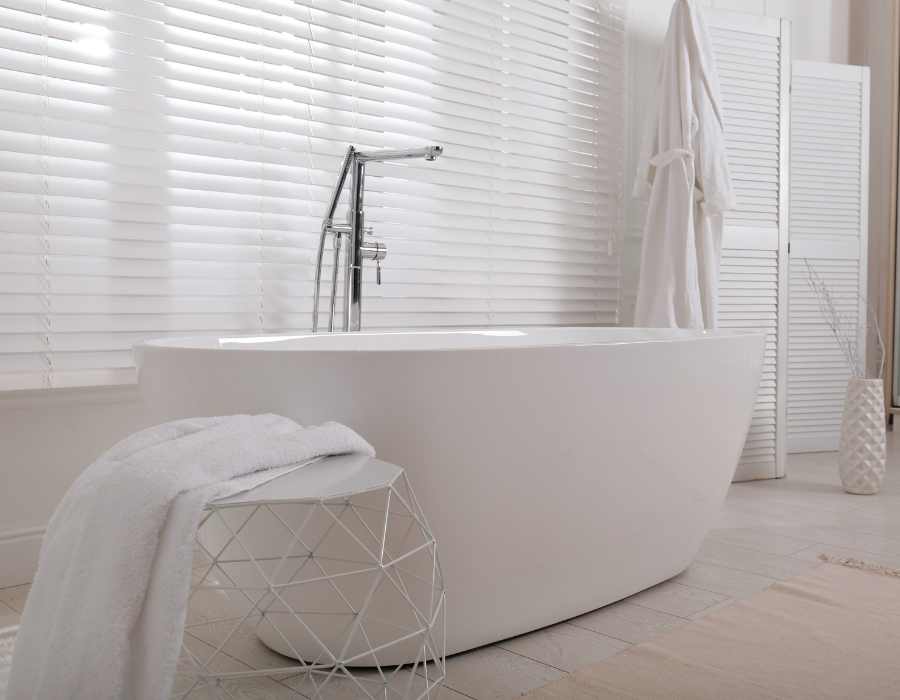
In Summary
Whether you’re drawn to the durability and classic appeal of cast iron bathtubs, the modern look of stone resin, or the unique charm of wood, there’s a material out there that meets your needs. Consider your lifestyle, budget, and bathroom design to choose the right tub material that will enhance your bathing experience for years to come.

